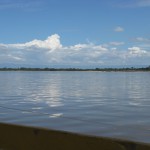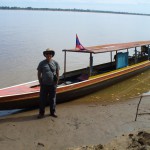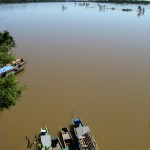
We’ve been moving southward in Laos, following the direction of the Mekong River, and we find ourselves once more spending many hours on its waters.
Here at the southern end of the country, the river is at first much wider than in the north after it has gathered waters from other rivers like the Nam Ou and the Khone, perhaps a kilometer across at times. And its name has other meanings, we’re told, as Mai Kong, the mother of all things.

Like almost all other craft on the river, our boat this day was a 3 foot wide, 25 foot long fishing boat powered, if that is the appropriate word, by a tiny engine and an upright plastic container for fuel. The boats move maybe 7 or 8 miles per hour on their own, and the current at this time of year is just 3 or 4 mph, so it takes a while to get anywhere even going downstream. Our 50 mile trip took five hours, including a quick toilet stop on the banks at one point.
So this is not something you would do on a fast tourist trip to the area, and you can skip much of the river by driving. But the enforced relaxation proves actually quite refreshing for a traveler on the move. So we pretty much lazed the hours away, and had the privilege to observe in that pause the timeless interaction of both the people and the sky with this impressive river.

Many villages perch upon stilts on the banks, close to their food supply, with crops growing out of the sandbank itself and many fishing nets evident in the water from the plastic bottles on the surface that marked their location. Perched on their traditional fishing boats, similar to ours but shorter and simpler, villagers set and checked their nets in the middle of the river. Some paddled and some putt-putted like us, but these were the only other boats we saw during the whole five hour trip, except for a brief and anachronistic appearance of just one speedboat. Our curious guide often asked these fishers if they have caught anything…sometimes yes and sometimes no. And we were reminded of the precariousness of life on this river.

Precarious. For the river is not always kind. It may not give up a fish for the dinner plate, despite the laborious setting and tending of nets, and the crops may bring sufficiency in a good season or not. With climate change come other hazards threatening what should be a comfortable life in the midst of tropical plenty. The river banks told more stories, for you can see from the banks how the river rises and falls in height about 15 feet over the span of a year. When it rains more, such as this past year, the crops and stilt-supported houses along the shore can wash away with this massive torrent. You see many trees fallen down along the river banks and some lopsided, capsized buildings as well.
The work never stops along the river, it seems, but there is also a delight you see in the faces of people despite these challenges and perils, especially in the children. As we near the shore on occasion, more often than not the villagers and children working their tiny plots would wave and halloo us, as did the huddled men in their small fishing boats.

Over five hours, the scenery is ever-shifting, but never much different. The low level greenery on the land to left and right just trails by. On this day, the horizon ahead was progressively adorned by those massing cloud formations typical of the afternoon. At times the sky seemed to trail off into endless space, with the river narrowed to a dot within the receding banks ahead.
The purpose of such a trip, according to the guidebooks anyway, is to experience a different quality of the Mekong at Si Phan Don. There the river splits and divides into islands, that they say number 4000. The next day, as the portion of the river we were on narrowed, you could see how the once broad Mekong sprawled around islands and sandbars and clumps of fallen trees. The channels went in many directions, threatening even our very shallow boat and more reminiscent at times of passages through a bayou than a major riverway. Only about a hundred of these islands are habitable, as some are up to 10 miles wide and 20 miles long, for the river claims many back when it surges.

All this division culminates in a wall of granite boulders cutting several miles across the most southern set of islands and turning the river into a churning set of waterfalls. This natural dam forces the water to cascade in hundreds of routes to get past the rocks so it appears water flows and funnels from everywhere at once. You don’t boat through there, though at times you can run these rapids on a raft. Even the French had to go around these obstacles with a rail line on one of the islands.

And then, it’s the Mekong again. Past one set of falls, the river could not have contrasted more with the turbulence just above it. So wide and placid at this point, it looked like a lake with a barely perceptible current that slowly spun our boat, but didn’t seem to move us much. There in a real fishing boat, in perfect quiet and still water, we kept a patient vigil to hear the whale-like air blowing of the endangered, freshwater Irawaddy dolphins as they arced to the surface and slid silently back into the water. A species long present in these waters, but perhaps not to grace them for much longer.
At first, we thought that the time to be spent here on the middle part of the river was much too long. But then, yielding to it, letting its life flow by, we found a tranquility of soul that we shared with the children of this Mother of All Things, this Mekong, and that we wish for their families.
(For the first part of our Mekong travels, CLICK HERE.)
(And for more pictures from Laos, CLICK HERE to go to the Itinerary page for Laos and view the slideshow at the end.)


I’m always in favor of lazy days